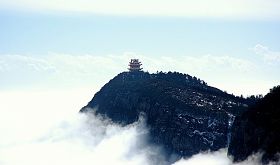Difference between revisions of "Mount Emei" - New World Encyclopedia
Dan Davies (talk | contribs) (imported, credited, fixed) |
Dan Davies (talk | contribs) |
||
| Line 1: | Line 1: | ||
| − | |||
| − | |||
{{Infobox World Heritage Site | {{Infobox World Heritage Site | ||
| WHS = [[Mount Emei|Mount Emei Scenic Area]], including [[Leshan Giant Buddha|Leshan Giant Buddha Scenic Area]] | | WHS = [[Mount Emei|Mount Emei Scenic Area]], including [[Leshan Giant Buddha|Leshan Giant Buddha Scenic Area]] | ||
Revision as of 00:24, 3 September 2008
| Mount Emei Scenic Area, including Leshan Giant Buddha Scenic Area* | |
|---|---|
| UNESCO World Heritage Site | |

| |
| State Party | |
| Type | Cultural |
| Criteria | iv, vi, x |
| Reference | 779 |
| Region** | Asia-Pacific |
| Inscription history | |
| Inscription | 1996 (20th Session) |
| * Name as inscribed on World Heritage List. ** Region as classified by UNESCO. | |
| Mount Emei | |||
|---|---|---|---|
| Elevation | 3,099 metres (10,167 feet) | ||
| Location | Sichuan, China | ||
| Geographic coordinates | {{#invoke:Coordinates|coord}}{{#coordinates:29|31|11|N|103|19|57|E|type:mountain | name=
}} | |
Mount Emei (Chinese: 峨嵋山; pinyin: Éméi Shān; Wade-Giles: O2-mei2 Shan1, literally towering Eyebrow Mountain) is a mountain in Sichuan province of Western China. Mount Emei is often written as 峨眉山 and occasionally 峩嵋山 or 峩眉山 but all three are translated as Mount Emei or Mount Emeishan.
Mt. Emei is one of the Four Sacred Buddhist Mountains of China. The patron bodhisattva of Emei is Samantabhadra, known in Chinese as Puxian (普贤菩萨). 16th and 17th century sources allude to the practice of martial arts in the monasteries of Mount Emei.[1] made the earliest extant reference to the Shaolin Monastery as Chinese boxing's place of origin.[2]
A large surrounding area of countryside is geologically known as the Permian Emeishan Large Igneous Province, a large igneous province generated by the Emeishan Traps volcanic eruptions during the Permian Period.
Mt. Emei was made a UNESCO World Heritage Site in 1996.[3]
The Emei Shan Liocichla, a passerine bird is named after the site.
Architecture
This is the location of the first Buddhist temple built in China in the 1st century CE.[3] The site has approximately seventy Buddhist monasteries of the Ming and Qing period, most of them located near the mountain top. The monasteries demonstrate a flexible architectural style that adapts to the landscape. Some, such as the halls of Baoguosi, are built on terraces of varying levels, while others, including the structures of Leiyinsi, are on raised stilts. Here the fixed plans of Buddhist monasteries of earlier periods are modified or ignored in order to made full use of the natural scenery. The buildings of Qingyinge are laid out in an irregular plot on the narrow piece of land between the Black Dragon River and the White Dragon River. The site is large and the winding foot path is 50 km, taking several days to walk.[4] There are cable cars to top level of the mountain.
Images of Mount Emei
Macaque indigenous to the region
See also
- Sacred Mountains of China
- Zuo Ci
Notes
- ↑ Zhāng Kǒngzhāo 張孔昭 [c. 1784]. Boxing Classic: Essential Boxing Methods 拳經拳法備要 Quánjīng Quánfǎ Bèiyào (in Chinese).
- ↑ Henning, Stanley E. (Fall 1999a). Academia Encounters the Chinese Martial Arts. China Review International 6 (2): 319–332. ISSN 1069-5834..
- ↑ 3.0 3.1 Mount Emei Scenic Area, including Leshan Giant Buddha Scenic Area. UNESCO. Retrieved 2007-09-06.
- ↑ Dazhang, Sun (2002). Chinese Architecture—The Qing Dynasty, English Ed., Yale University Press, pp 328–329. ISBN 0-300-09559-7.
ReferencesISBN links support NWE through referral fees
External links
- Religion and the environment in China, 中国的宗教与环境 - chinadialogue article
- Mount Emei, including Leshan Giant Buddha, Scenic Area: official Unesco site
- Tours and Travel to total Solar Eclipse 2009 to China on Mt. Emei Shan
| |||||||
| ||||||||









